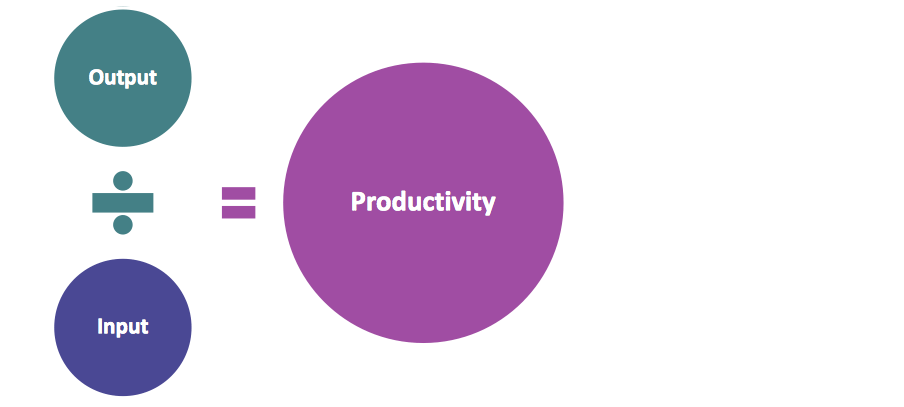The importance of productivity cannot be underestimated. Governments are obsessed with productivity indexes, businesses want more from the same resources and unions want to be rewarded based on how they have contributed to productivity improvements.
In simple terms the following diagram defines what productivity is:

Your outputs need to be greater than you inputs, or else you are going backwards.
The search for productivity extends back to the beginning of the industrial age when Taylor had his stopwatch and measured how more could be achieved from existing railroad employees who were unloading ore in the 1880’s (to read the details click on the following link: Taylorism)
The industrial age generated many studies trying to determine how to unlock human potential and maximise each person’s contribution. My favourite study was the Hawthorne Effect, and I believe, it still stands the test of time today. Briefly, it described the affect of changing lighting conditions at the Hawthorne Works near Chicago. In essence the findings showed that if managers showed an interest in their workers output, productivity improved (to read the details click on the following link: Hawthorne Effect). The other important finding which often gets missed is that unless interest is maintained the productivity improvements are shortlived.
In 1959 the European Productivity Agency at a conference in Rome sumarised their thoughts as:
Productivity is, above all, a state of mind. It is an attitude that seeks the continuous improvement of what exists. It is a conviction that one can do better today than yesterday, and that tomorrow will be better than today.
In my mind this is a relevant today as it was in 1959.
So how do we become more productive?
Peter Drucker the post World War doyen of Business Improvement said:
“Without productivity objectives, a business does not have direction. Without productivity measurement, a business does not have control.”
And James Harrington reminded us that:
“Measurement is the first step that leads to control and eventually to improvement. If you can’t measure something, you can’t understand it. If you can’t understand it, you can’t control it, and if you can’t control it, you can’t improve it.”
So in simplistic terms, I see that there are three key steps:
- Be Aware (there are two parts to this)
- Objectively measure your current performance.
- Work out what you need to do to improve and by how much to be competitive
- Work through what the obstacles are that prevent improvements. This may require that some or all of your staff need to be educated and involved
- Take Action. Remove the obstacles, measure your performance and publish the results (the publishing of results is particularly important so that progress can be seen to be made)
These steps may require the appointment of a “Productivity Improvement Manager” or for the business to employ a business consultant who specialises in Business Improvement. The point here is if improvement progress is to be made, real focus from the owner/business manager is necessary.
It is extremely rewarding to watch a focused workforce finding ways to improve what they do.
I contend that involving your staff through awareness and training is the key part of delivering productivity improvements. Some employers foresee that a better trained employee is more desirable to other employers who might then poach the improved employee. I believe this is short term thinking. Although there is a risk of lost investment in human capital if a trained employee leaves, this is and has always been a risk for orgamisations. SME’s would be better able to control this risk by aiming to be an employer of choice which gives incentives that encourage personnel to stay.
Despite the numerous reasons for a business to embrace Technology, SME’s must realise that technology, by itself, won’t foster productivity gains and cost savings. SME’s need to first understand and assess their business – mapping its people, processes and technology against their bottom line. Only then will business understand if and how technology measures will help to bridge the gaps. This also allows the consideration of the business case to justify the costs, as is inevitable with new technology
In a highly competitive environment, SMEs have to focus on productivity to meet the requirements of customers; they must nurture a strong productivity mindset and embrace continuous productivity improvement on a company-wide basis. Large enterprises will also benefit from labour productivity increases in SMEs. For instance, by supplying high quality intermediate goods and services, small firms will positively influence productivity of larger firms. Further, by increasing their productivity, smaller firms are more likely to actually compete on an equal footing with larger firms.
I believe that continuous productivity improvement is critical for the long-term competitiveness and profitability of SMEs, as well as their survival. As the most significant employer in Australia, SME's need to develop the employees mindset whereby they can see that productivity will deliver a competitive advantage that will lead to a stable environment for all of the companies employees
It does require constant effort for the organisation to adapt to the prevailing economic activities in the ever-changing business environment to create value for all the businesses stakeholders. But successful productivity improvements will raise business morale and be financially rewarding.
By the way, there are government schemes available that financially encourage SME’s to enhance productivity, and to innovate.
If you are interested in productivity improvements, Robert can be contacted by e-mail; This email address is being protected from spambots. You need JavaScript enabled to view it. or mobile 0422 913 203.

